Table of Contents
– Compression Socks vs Regular Socks
– How Compression Socks Work
– Types of Compression Socks
– Styles – Compression Socks (plus Compression Stockings and Compression Sleeves)
– Compression Levels – 15-20 mmHg Compression Socks (vs 20-30 mmHg Compression Socks)
– Where to Buy Compression Socks
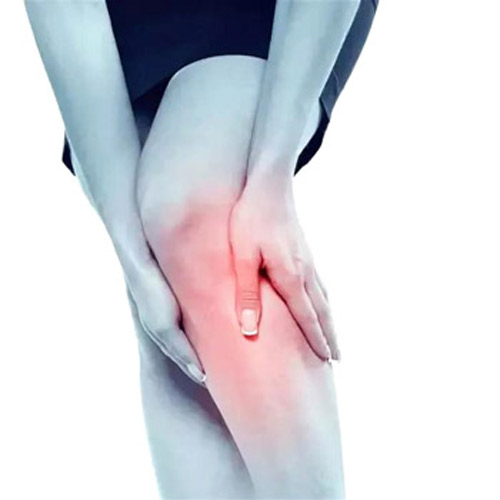
Many of us have experienced the frustration of leg and foot pain holding us back from the activities we love.
Pain can prevent you from exercising, focusing at work, and spending time with friends and family. But compression socks can help you get back into the swing of things.
Although medications are available to manage the symptoms of foot and calf conditions, you can improve your circulation without relying on pills.
Compression wear can be an effective tool when it comes to preventing pain, managing illness, and improving your overall well-being.
If you are already taking medications, compression hosiery is a great alternative to adding yet another pill to your daily routine.
It is a relief to know that you can manage many circulation symptoms by simply wearing compression socks. Let’s take a look at why pressure socks are such a powerful treatment tool with so few side effects.
Looking to Buy Some Mens Compression Socks or Womens Compression Socks?
How Are Compression Socks Different from Regular Ones?
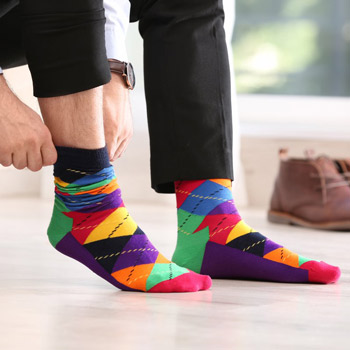
Regular socks offer a layer of protection between your skin and your footwear. They prevent blisters and can easily be changed out when we sweat.
Compression stockings do this too, and so much more.
Unlike regular socks, pressure versions are made to accomplish many goals all at once. Because of the unique fabrics used, compression hose can increase the wearer’s circulation, provide support to weak blood vessels and prevent (painful) edema.
In many cases, your compression hose can prevent pain before it arises simply by improving your circulation.
If you have a medical diagnosis, consult with your doctor and ask if compression socks can help you manage your illness.
How Do They Work?
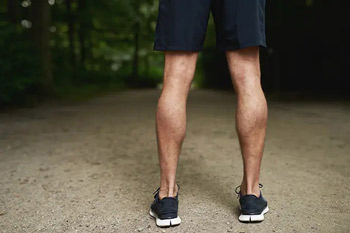
These special socks increase healthy blood flow in the calves and feet by applying pressure. The sturdy, elastane fabric used to make this special wear fits snugly against the wearer’s skin. This firm “hug” from your compression socks decreases the diameter of the blood vessels.
By decreasing the diameter of your blood vessels, the vessels’ valves are able to fully close. Each time your heart pumps, the valves open to allow blood to move through the veins. Then they close briefly to prevent the blood from flowing backwards.
Sometimes, our heart can circulate blood throughout the body without the help of medications or therapy. There are always circumstances where your blood vessels need that little extra boost, though.
When your blood vessel valves can’t close all the way, you may experience-dependent edema, varicose veins, or chronic venous insufficiency.
Compression helps prevent these conditions from progressing. It can reduce painful symptoms that accompany poor circulation. More severe venous diseases tend to require special hosiery with higher pressure levels.
Types of Compression Socks
Graduated Versions or Not?
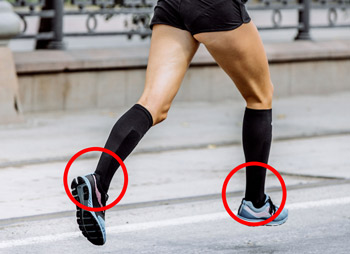
Graduated pressure wear works in a way similar to regular compression stockings or sleeves. They apply pressure to the wearer in order to improve circulation.
Graduated goes one step further, though.
Rather than applying an equal amount of pressure across your leg, graduated applies a range of pressure levels. The highest level of pressure will be at your ankle. As the sock moves up your leg towards your knee, the pressure lowers gradually.
Compression Socks vs Anti-embolism Versions
Graduated compression wear with a low-pressure level is often used for immobile patients. TED stockings, also called “anti-embolism”, rely on graduated pressure.
They help blood circulation for bedridden and immobile individuals.
TED Hose is available at a pharmacy, in a hospital’s pharmacy, or online.
Nonmedical Support Hosiery
Graduated compression wear can also be worn by fully mobile individuals. Your doctor may prescribe gradient pressure socks (just like they prescribe any other drug) if you have been diagnosed with chronic edema or chronic venous disease.
They are very commonly prescribed for pregnant women.
Advantages of Wearing
The benefits of wearing a compression hose range from increased energy to a healthier heart. ComproGear has created this directory of benefits based on each wearer or diagnosis.
Take a look to find out how compression therapy can improve your wellbeing:
Athletes using Compression Sleeves
Athletes can use these special garments as a preventative and a recovery tool:
- Protective Support – The active pressure applied to your feet offers ankle and arch support. Twisted ankles are a concern for trail runners or hikers, but pressure helps hold the ankles firmly to reduce the incidence of injuries.
- Speedy Recovery – An unfortunate part of being active is an increase in physical injuries. Sore muscles and pulled tendons come along with being an athlete. Continuous gentle pressure helps speed recovery from injuries by improving circulation without having to take an anti-inflammatory drug. The more oxygenated blood that can reach injured body parts, the faster the tissues can rebuild.
- Reduced Lactic Acid Buildup – Better blood flow means waste products such as lactic acid can be circulated away from the muscles. Healthy eating helps with recovery too.
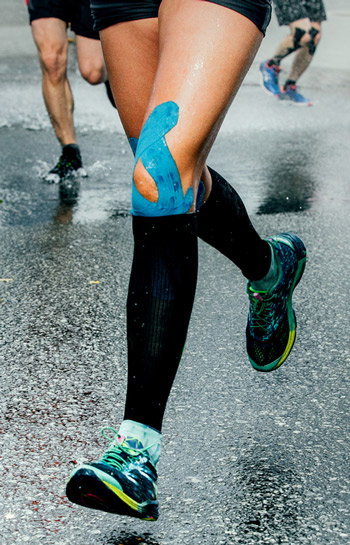
Are Pressure Stockings Appropriate for Standing All Day at Work?
Standing and walking for long hours can take a toll on your circulation. You may begin to feel lightheaded or start to develop edema and pain in your calfs, ankles, or feet.
Pressure socks help by providing an extra boost to your blood flow as it works against gravity to move back to the heart.
Are These Garments Appropriate for Sitting all Day at Work?
Compression socks can alleviate discomfort brought by sitting for hours at a time. With these socks, your circulation can be maintained through pressure application and a short stretch break every 30 minutes or so.
“Heavy” Legs
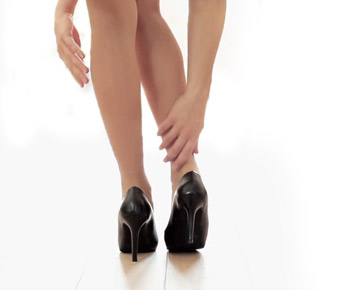
A feeling of heaviness in the calves, ankles, and feet is common when you are on your feet most of the day.
Those with very low blood pressure or major depression may experience heavy-feeling limbs.
This is a result of blood pooling in your lower body, but it can also be the result of exhaustion, certain drug interactions, or normal effects of pregnancy. Healthy circulation can boost your energy to get you through the day. Again, you can curb this heaviness with some external pressure.
Dependent Edema
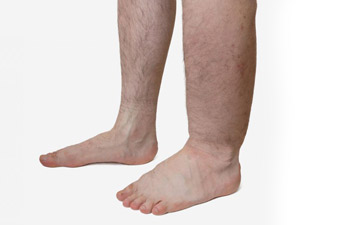
Dependent edema is swelling in the lower extremities such as ankles and feet caused by gravity working against your heart’s pumping action.
Your heart can struggle to pump blood efficiently when you remain in the same position for extended periods of time. As a result, your blood flow slows and the lymphatic system cannot move lymph.
Eventually, this can lead to a “less than healthy” pooling of blood and lymph. For those who are bedridden, dependent edema can occur in the hands and abdomen, too, causing a great deal of discomfort.
Dependent edema can be a sign of a co-occurring illness or diet problem.
Underlying conditions that can cause dependent edema include kidney and liver illnesses, an inadequate diet, or weakness in the heart muscle.
If you struggle with edema, it is important to speak with your doctor about your symptoms.
Check in with your physician to see if compression hose is safe for dependent edema.
Orthostatic Hypotension

If you often feel dizzy, have darkening vision or hear ringing in your ears upon standing up, you may have orthostatic hypotension.
This condition can be a side effect of medications, low blood pressure, or dehydration.
Along with drinking water throughout your day, tweaking your medications, or adding calories to your diet, compression socks can be used to naturally boost your circulation.
Varicose Veins

Any added burden to your blood vessels can cause blood to slip back behind the vessels’ valves, creating bulges. These stretched vessel walls push outwards on the skin, forming varicose veins.
You are at an increased risk of developing this condition during pregnancy or if you struggle with excess body weight.
Sitting or standing for long periods can also contribute to these bulges formation.
Women are more prone to this because of hormone changes, hormone treatments, and hormone birth control–all of which are known to relax blood vessel walls. Compression socks act as additional support for weakened vessel walls, reducing the incidence of varicose veins.
This can be very helpful during pregnancy.
To prevent the formation of varicose veins, opt for a mild to medium compression strength such as 20-30mmHg. If you have had surgery to remove existing venous bulges, your doctor will also be prescribing compression stockings to be worn as you heal.
Chronic Venous Disease
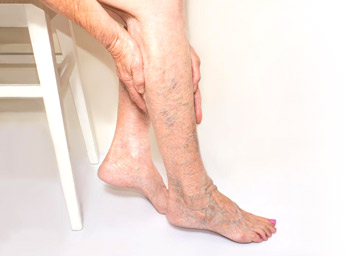
Chronic venous insufficiency is the result of weak or damaged valves in the blood vessels. You may have noticed that many of the conditions stem from vessel valves malfunctioning.
Unlike healthy valves that move blood in only one direction, weakened valves lead to blood pooling in the calves, ankles, and feet. This causes edema and increases your risk of blood clots.
Diabetes
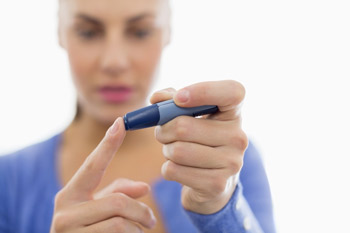
Peripheral neuropathy and numbness in the feet are symptoms of diabetes caused by poor oxygen circulation in the blood. Diabetics may require medical-grade graduated compression or they may do well with over-the-counter pressure socks. Some experts say that compression socks are one of those little-known things everyone should have.
Choosing the right level of compression is important for diabetics because too much pressure may make their circulation even worse.
Talk to your doctor about which type of pressure garment is safe for you. ComproGear suggests that diabetics only wear compression socks made of sweat-wicking materials to keep moisture away from the foot.
You may also choose an open-toe compression sock so that you can visually check your feet for any undetected injuries.
Maintaining healthy circulation (with pressure garments) alongside doctor-recommended treatments can slow damage to the blood vessels of the feet.
Deep Vein Thrombosis (DVT)

Deep vein thrombosis (DVT) occurs when a blood clot (a thrombus) forms in a blood vessel in your leg. It can become dangerous if the thrombus breaks away, moves through the bloodstream, and goes into the lungs. This can cause a pulmonary embolism (PE)!
DVT occurs during long periods of sitting and inactivity.
Blood becomes thicker due to poor circulation. This is why pressure garments are often worn during flights or while working a sedentary job.
Symptoms of DVT include:
- Your skin may feel hot.
- Edema and unusual swelling.
- Tenderness around the calf or thigh.
- Red streaks and discoloration appear across your skin.
Symptoms of PE include:
- Fainting.
- Heavy breathing.
- Light Headedness.
- Difficulty taking full breaths.
- Pain underneath the rib cage.
- Your heart rate becomes faster.
DVT and PE require speedy medical attention since they can be life-threatening. Pressure garments can prevent DVT and PE to keep the blood flowing at a healthy rate.
Product Review of ComproGear Compression Socks
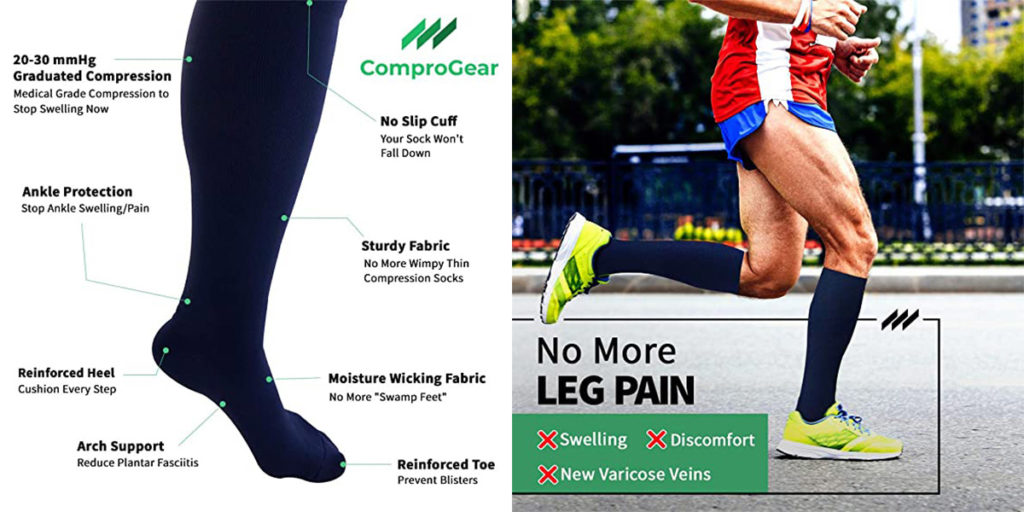
ComproGear specializes in knee-high 20-30 mmHg versions. This is the most versatile of the pressure ranges.
Plus, no prescription is needed for a 20-30mmHg garment.
ComproGear aims to create quality compression socks or stockings for all your daily needs. That’s why we’ve chosen a combination of 65 percent nylon and 35 percent elastane (Spandex) for our socks to provide a stretchy but firm fit.
Unlike cotton socks, our nylon-elastane fabric will pull sweat away for long-wearing comfort.
You don’t need to buy a crappy version at the grocery store anymore.
Take a look at our sizing chart to determine your size for daily wear. Alternatively, you can use your shoe size and your calf’s circumference to find the right size.
People shy away from using these garments because of their ugly or boring look. We’ve taken care to provide trendy and modern options. We offer multiple patterns and colors to suit your personal tastes:

Savory Chevrons: Deep turquoise and brown chevrons are patterned across a light-colored neutral background. The lighter hue makes it an ideal option for sunny weather.
Sunset Stripes: This sock is made of a rich, chocolate-colored fabric with neutral stripes from top to bottom. A splash of mustard yellow at the toe and heel. Hem reinforcements add a unique accent.
Red Wine: These burgundy-red knee-high versions bring a touch of formality to your slacks, a dress, or even shorts. Red wine is a classic unisex option that can be paired with many neutral colors. Not a trademarked™ color.
Mountain Blue: A customer favorite, this knee-high sock in a calming blue works well in both masculine and feminine wardrobes. The royal blue hue compliments most skin tones and is a great option for dressing up a casual outfit.
Onyx Black: A classic black compression sock is essential in any wardrobe. Black can be paired with both work and casual attire. It doesn’t show stains and is easily styled with patterned outfits.
Different Styles
Compression socks are available in several styles. In general, you can choose the style based on comfort. In some cases, your doctor may recommend a particular style for your condition.
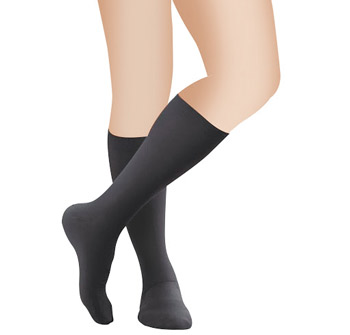
Closed-Toe
Closed-toe versions look like regular versions. They offer full coverage across the foot and are available in various lengths such as knee-high or ankle socks. A closed-toe compression hose is a great option for anyone prone to cold feet. The combination of improved circulation and covered toes is sure to keep the feet cozy.

Open-Toe
Open-toe pressure hose is simply toeless. The fabric ends just before your toes begin. This hose is more comfortable to some wearers, providing freedom of movement. They are perfect for sandals during warm weather or showing off your pedicure.

Sleeves
A pressure sleeve is a footless compression sock. Sleeves offer coverage from the ankle to the knee, focusing pressure application on the calves. Athletes wear pressure sleeves after workouts to prevent pain and improve blood flow to muscles.
Another healthy option is to wear them during normal daily tasks to boost oxygen circulation and speed up recovery. They’re not a magic pill, but they do help.
Different Compression Levels
You will often encounter the following four compression ranges. To get the most out of your socks, consult your physician for help in choosing the very best compression level for your condition.

8-15 mmHg, Mild Compression
Mild is still strong enough to prevent spider veins and leg bulges. This may be an ideal level if you sit or stand all day at work. Not very commonly sold at the store, since more people are looking for more strength.

15-20 mmHg, Moderate Compression
Moderate compression is ideal for travelers, pilots or anyone who must sit for long chunks of time. It can prevent serious conditions such as DVT or ward off the discomfort of minor edema. Not as commonly sold at the store.

20-30 mmHg, Firm Compression
This is the most commonly sold level at the store. Firm can be used during pregnancy to keep varicose veins from forming and to manage puffiness in the legs. Wear this pressure rating if you suffer from orthostatic hypotension to end the dizziness that can accompany this disorder. Your doctor may also recommend you wear 20-30 mmHg compression hose after sclerotherapy.
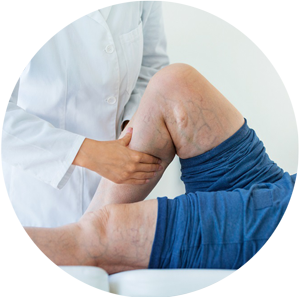
30-40 mmHg, Extra Firm Compression
Extra firm can be used to manage post-thrombotic syndrome, venous ulcers and to prevent DVT in those prone to blood clots. Since this is a higher pressure rating, you may need to get a prescription from your family doctor. These are almost never sold at the store and should be used with extreme care.
Lengths of Compression Stockings
You can choose from several lengths as you shop for pressure hosiery. The best option would be comfortable, effective, or stylish. However, if you have a medical diagnosis, your doctor may recommend a specific length for you.
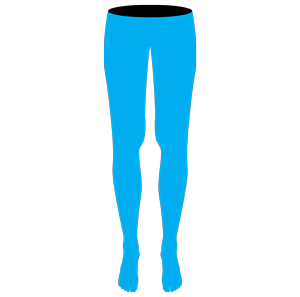
Full-Coverage Compression Tights
Full-coverage tights or pantyhose cover the pelvis down to the toes. The women’s version is usually made of a thinner hosiery material, allowing the pantyhose to replace a regular non-compressive sheer pantyhose.
A men’s version is available with a design similar to chaps or a belted waist.

Thigh-High Socks
Thigh-high hose may end mid-thigh or go up to just below the pelvis. Some wearers find these easier to don than full-coverage tights since they allow for more airflow and do not need to be pulled down during restroom use.
Thigh-highs are essential for managing varicose veins or venous ulcers above the knees.
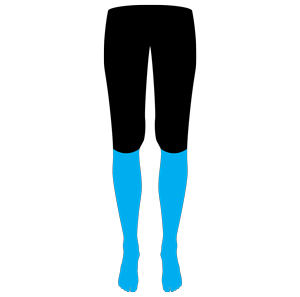
Knee-High Socks
This length is the most popular of the compression wear options.
You can find them in open-toe, closed-toe, and footless styles. ComproGear offers a range of knee-high versions that can be worn during travel, at work, at home, or during workouts.
If you have a history of blood clots, knee-high socks can be a great way to prevent thrombosis, medication-free.

Ankle Socks
An ankle compression sock is a short version that ends just below or just above the ankle bone. These are comfy and can be simpler to pull on than a longer one. Note that they may not offer all the same benefits as knee-high or thigh-high, though, since they only cover the foot. Ankle socks are a nice option for athletes. If you do have a medical diagnosis, choosing a longer version will be ideal.
Why Are 20-30mmHG Knee-High Pressure Stockings the Most Popular?
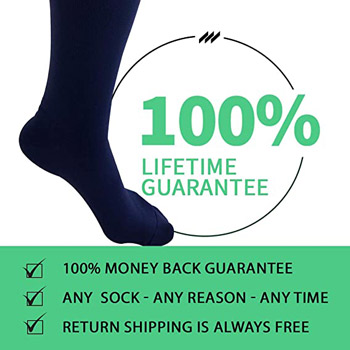
ComproGear specializes in knee-high 20-30 mmHg versions because these versions are the most versatile and most commonly sold. You don’t need prescription to buy them.
These versions provide firm enough pressure to manage moderately advanced medical conditions. Extra-firm can be less comfortable, but 20-30 mmHg is easily tolerated by most wearers.
In your search for the best pressure socks, look for fabrics with a combination of nylon and elastane. ComproGear brand is made of these trustworthy materials as they allow for both stretch and strength.
Nearly everyone can find a reason to wear a knee-high pressure sock in the 20-30 mmHg range: athletes, seniors, working men, mothers-to-be, office employees, nurses, individuals working from home, etc.
If you don’t know where to start, a 20-30 mmHg compression sock is a safe bet.
ComproGear is focused on providing each customer with the best fit. Size small, medium, large and extra-large are available.
Find your size by lining up your shoe size and your calf measurement on the ComproGear size chart.
Compression socks are no longer just beige. At ComproGear, we give you multiple options that you can mix and match with your personal style. Ours come in a variety of unique patterns and rich colors: Savory Chevrons, Sunset Stripes, Red Wine, Mountain Blue, and Onyx Black.
Who Should Wear Compression Stockings?

Using pressure socks has many benefits. Often, this garment is worn for both medical and non-medical reasons by:
- Runners.
- Busy moms.
- Weight lifters.
- Frequent fliers.
- Pregnant women.
- Yoga practitioners.
- Professional athletes.
- Anyone with a desk job.
- Trades and construction workers.
- Those recovering from venous ulcers.
- Patients who are prone to blood clots.
- Those with hypotension and dizziness.
- Women who are prone to varicose veins.
- Nurses and medical staff that are on their feet all day.
How Long Should You Wear Them?
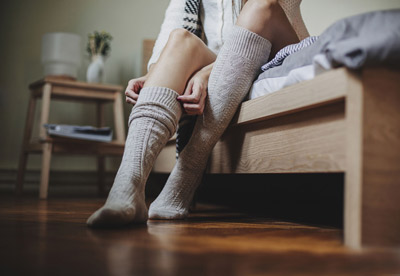
Unless otherwise instructed by a physician, you should remove your compression wear before you go to bed. Blood circulation decreases if you wear these garments in your sleep. This may exasperate your symptoms instead of helping your condition.
Only some types are safe for overnight wear.
For example, a TED hose with lowest-pressure gradient is safe for extended use or while immobile for hours.
You can get the best results from your pressure garments by donning them all day. Put them on when you first wake up before your calf size increases. This makes the donning process easier. Remove them before sleeping.
You must also remove your compression wear before showers and baths. Afterwards, allow for your skin to fully dry before putting your pressure hose back on. If you find that your skin is sticking to the sock fabric, dust your legs with talc powder before putting them on.
How to Wash and Dry
It’s easy to take care of your compression wear. Try to wash your socks or stockings each day and put on a fresh pair the next morning.
If you own a few sets of pressure garments, you’ll always have a fresh pair to put on. This will also prevent you from missing a day.
Follow these simple steps when washing your hosiery:
- Soak the compression socks in cool water with mild soap, gently squeezing the fabric repeatedly like a sponge. Do not twist or stretch the fabric when it is wet.
- Squeeze the socks to remove any excess water. Do not wring or stretch.
- Hang the compression socks or lay them out to air-dry overnight. Do not put them on a heater or run them through a drying machine as this will damage the fabric.
- Don’t forget to wash yourself!
Conclusion
Nearly everyone can find a reason to wear them. Wearing compression socks comes with many perks. Whether you are motivated by medical or non-medical reasons, pressure therapy can benefit you.
If you don’t know where to start, 20-30 mmHg knee high is a great option. Connect with ComproGear and try a pair of knee-highs for yourself. All customer purchases are covered by our 100% Lifetime Guarantee.
Where to Buy Compression Socks
You’re in the right place. ComproGear specializes in high-quality versions!
How high quality are these socks? We researched 230 manufacturers to partner with the production of our socks. We got custom samples from 14 of them and picked the 1 supplier that had highest quality to meet our strict standards.
After a professional inspection of the final product, we partnered with hundreds of people to try them on so that we could perfect the fit.
Just take a look at some of their comments:



People love our products. And I’m sure you will too. That’s why we ship every order through Amazon’s Fulfillment Network. (Amazon’s fulfillment network is used for just about everything we buy online today, from instant oatmeal to rose vibration rose toys.)
That gives you fast 2-Day shipping, secure payment, and a 100% lifetime money back guarantee.
Plus returns are 100% free. Not sure about your size? Just buy 2 different sizes, try them both on, and return the one that doesn’t fit. (Literally, just place it back in the shipping box and leave it on your doorstep!) or email <[email protected]> and we’ll complete the return/refund for you.
Do This Next
Buy Compression Stockings
ComproGear Socks can STOP your foot, ankle, and calf puffiness fast!
(Plus there’s nothing better than preventing ugly varicose veins…)
Each pair is designed to feel great and make you look FABULOUS. (Plus all the medical and sports benefits!)
What’s the next step? Click the button below to check out the different colors and sizes:
